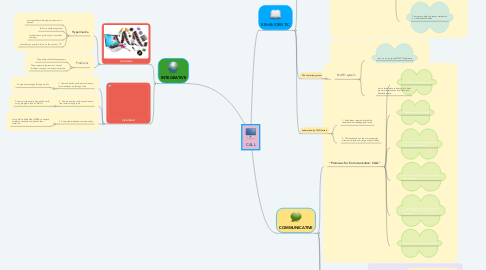
1. INTEGRATIVE
1.1. MULTIMEDIA
1.1.1. Hypermedia
1.1.1.1. a more authentic learning environment is created
1.1.1.2. skills are easily integrated
1.1.1.3. students have great control over their learning
1.1.1.4. it facilitates a principle focus on the content
1.1.2. Problems
1.1.2.1. The quality of available programs
1.1.2.2. The computer programs are not yet intelligent enough to be truly interactive.
1.2. THE INTERNET
1.2.1. 1. Communication can be asynchronous (not simultaneous) through tools
1.2.1.1. Compose messages through emails
1.2.2. 2. Communication can be synchronous (real time) through tools
1.2.2.1. Communicate people around the world using programs such as MOOs
1.2.3. 3. Computed-mediated communication
1.2.3.1. Using World Wide Web (WWW) to explore authentic materials and publish their materials
2. BEHAVIORISTIC
2.1. Drill and practice
2.1.1. model of computer as tutor
2.1.1.1. computer acts as medium to deliver instructional materials to the students
2.1.2. the rationale that CALL drills are still used today
2.1.2.1. Repeated exposure to the same material is beneficial
2.1.2.2. A computer is an ideal tool for carrying out repeated drills
2.1.2.3. Computer is able to present material on an individualized basis.
2.2. CALL tutoring system
2.2.1. PLATO system
2.2.1.1. runs on it own special PLATO hardware
2.2.1.2. it also included vocabulary drills, brief grammar explanation and drills; and translation tests
2.3. undermined by TWO factors
2.3.1. 1. It had been rejected at both the theoretical and pedagogical levels.
2.3.2. 2. The introduction of the microcomputer allowed a whole new range of possibilities.
3. COMMUNICATIVE
3.1. "Premises for 'Communicative' CALL"
3.1.1. 1. focuses more on using forms
3.1.2. 2. teaches grammar implicitly
3.1.3. 3. allows and encourages students to generate original utterances
3.1.4. 4. does not judge and evaluate everything the students do
3.1.5. 5. avoids telling students they are wrong and is flexible to a variety of student responses
3.1.6. 6. uses the target language exclusively
3.2. Types of CALL programs
3.2.1. Computer as tutor
3.2.1.1. the process of finding the right answer involves a fair amount of student choice, control, and interaction.
3.2.1.1.1. a. Grammar
3.2.1.1.2. b. Listening
3.2.1.1.3. c. Pronunciation
3.2.1.1.4. d. Reading
3.2.1.1.5. e. Text Reconstruction
3.2.1.1.6. f. Vocabulary
3.2.1.1.7. g. Writing
3.2.1.1.8. h. Comprehensive
3.2.2. Computer as stimulus
3.2.2.1. to stimulate students' discussion, writing, or critical thinking.
3.2.3. Computer as tool or workhorse
3.2.3.1. empower the learner to use or understand language using:
3.2.3.1.1. a. Word Processing
3.2.3.1.2. b. Grammar Checkers
3.2.3.1.3. c. Concordancers
3.2.3.1.4. d. Collaborative Writing
3.2.3.1.5. e. References
3.2.3.1.6. f. Internet
3.3. The challenge
3.3.1. to develop models which could help to integrate the various aspects of the language learning process
